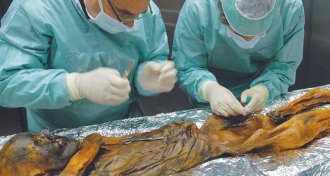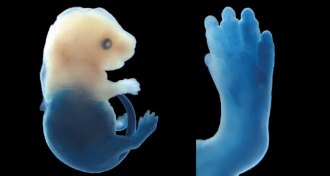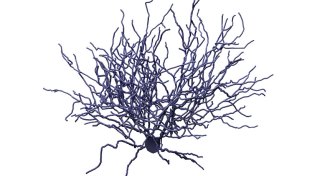Humans
Sign up for our newsletter
We summarize the week's scientific breakthroughs every Thursday.
-
 Archaeology
ArchaeologyRoman toilets didn’t flush parasites
Roman sanitation measures did little to dent parasite numbers, a study finds.
-
 Archaeology
ArchaeologyRoman toilets didn’t flush parasites
Roman sanitation measures did little to dent parasite numbers, study finds.
-
 Health & Medicine
Health & MedicineNew dietary guidelines emphasize big picture
Americans’ new guidelines for healthy eating focus on subtle shifts to dietary habits.
By Meghan Rosen -
 Genetics
GeneticsThe Iceman tells a new tale: Infection with ulcer-causing bacteria
Ötzi the Iceman was infected with a virulent strain of H. pylori. A new study is the first to piece together an ancient genome of these bacteria.
By Meghan Rosen -

-
 Microbes
MicrobesGet to know your microbes at ‘The Secret World Inside You’
The American Museum of Natural History’s newest exhibit rehabilitates bacteria’s bad reputation and introduces visitors to the microbiome.
By Devin Powell -
 Psychology
PsychologyKids grasp words as symbols before learning to read
Preschoolers grasp that written words refer to specific things before they learn to read.
By Bruce Bower -

-
 Health & Medicine
Health & MedicineHigh-intensity interval training has great gains — and pain
Intense spurts of activity followed by brief rest can improve heart health, blood glucose and muscle endurance. But some question if the pain of HIIT workouts will impede the popularity.
-
 Health & Medicine
Health & Medicine50 years ago, a promising agent pulled
DMSO was promised to cure everything from headache to the common cold. But human testing stopped in 1965.
-
 Science & Society
Science & SocietyClimate, new physics and Jupiter on the horizon for 2016
The first issue of the new year features stories about what will, editor in chief Eva Emerson predicts, hold on as scientific newsmakers during 2016.
By Eva Emerson -
 Tech
TechStretchy silicon sticker monitors your heartbeat
A new stretchy memory device looks like a temporary tattoo and works like a heart rate monitor.